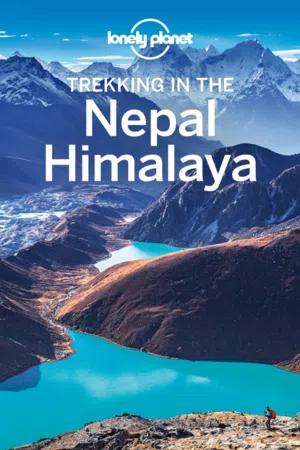
- English
- ePUB (mobile friendly)
- Available on iOS & Android
About this book
Lonely Planet: The world's leading travel guide publisher Lonely Planet Trekking in the Nepal Himalaya is your passport to the most relevant, up-to-date advice on what to see and skip, and what hidden discoveries await you. Tour through the hidden backstreet courtyards and temples of Kathmandu, explore the base of the world's highest mountain and learn everything you need to know to trek through this incredible region -all with your trusted travel companion. Get to the heart of the Nepal Himalaya and begin your journey now! Inside Lonely Planet Trekking in the Nepal Himalaya Travel Guide: Colour maps and images throughout Highlights and itineraries help you tailor your trip to your personal needs and interests Insider tips to save time and money and get around like a local, avoiding crowds and trouble spots Essential info at your fingertips - hours of operation, phone numbers, websites, transit tips, prices Honest reviews for all budgets - eating, sleeping, sight-seeing, going out, shopping, hidden gems that most guidebooks miss Cultural insights give you a richer, more rewarding travel experience - customs, history, environment Over 60 maps Covers Kathmandu, Everest Region, Annapurna Region, Langtang, Helambu, Eastern Nepal, Western Nepal and more The Perfect Choice: Lonely Planet Trekking in the Nepal Himalaya offers a comprehensive look at all you need to know to have a safe and rewarding trek. Looking for a guide focused on Nepal? Check out our Lonely Planet Nepal guide for a comprehensive look at all the country has to offer. Authors: Written and researched by Lonely Planet,. About Lonely Planet: Since 1973, Lonely Planet has become the world's leading travel media company with guidebooks to every destination, an award-winning website, mobile and digital travel products, and a dedicated traveller community. Lonely Planet covers must-see spots but also enables curious travellers to get off beaten paths to understand more of the culture of the places in which they find themselves. eBook Features: (Best viewed on tablet devices and smartphones) Downloadable PDF and offline maps prevent roaming and data charges Effortlessly navigate and jump between maps and reviews Add notes to personalise your guidebook experience Seamlessly flip between pages Bookmarks and speedy search capabilities get you to key pages in a flash Embedded links to recommendations' websites Zoom-in maps and images Inbuilt dictionary for quick referencing Important Notice: The digital edition of this book may not contain all of the images found in the physical edition.
Frequently asked questions
- Essential is ideal for learners and professionals who enjoy exploring a wide range of subjects. Access the Essential Library with 800,000+ trusted titles and best-sellers across business, personal growth, and the humanities. Includes unlimited reading time and Standard Read Aloud voice.
- Complete: Perfect for advanced learners and researchers needing full, unrestricted access. Unlock 1.4M+ books across hundreds of subjects, including academic and specialized titles. The Complete Plan also includes advanced features like Premium Read Aloud and Research Assistant.
Please note we cannot support devices running on iOS 13 and Android 7 or earlier. Learn more about using the app.
Information
Annapurna Region
Annapurna Region Highlights
Annapurna Himal
Annapurna Panorama Trek
Khopra Ridge Trek
Annapurna Sanctuary Trek
Annapurna Circuit Trek
Nar-Phu
Nar-Phu Trek
Mustang
Mustang Trek
Towns & Facilities
Pokhara
Naya Pul & Birethanti
Besi Sahar
Jomsom
Annapurna Region

Why Go?
When to Go
Best Mountain Views
Best of Mountain Culture
Annapurna Region Highlights

Table of contents
- Table of Contents
- Welcome to the Nepal Himalaya
- Nepal & the 2015 Earthquakes
- The Nepal Himalaya’s Top 9
- Need to Know
- If You Like
- Planning Your Trek
- Clothing & Equipment
- Trekking Safely
- Regions at a Glance
- Kathmandu
- Everest Region
- Annapurna Region
- Langtang, Helambu & Manaslu
- Eastern Nepal
- Western Nepal
- Understand Nepal
- Nepal Today
- History of Trekking
- History of Nepal
- People & Culture
- Environment & Wildlife
- Directory A–Z
- Transport
- Health
- Language
- Behind the Scenes
- Our Writers